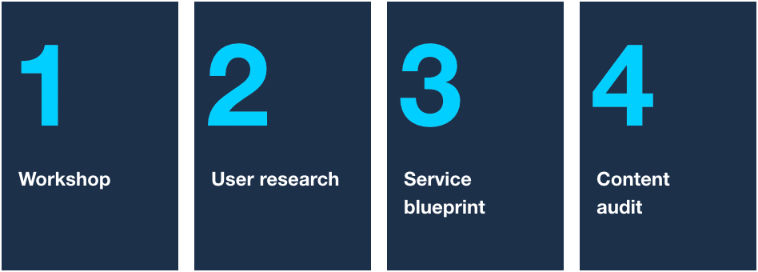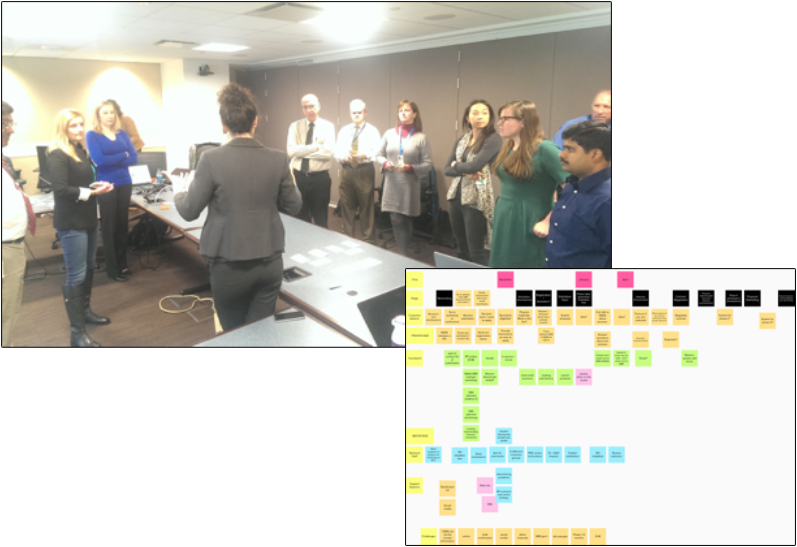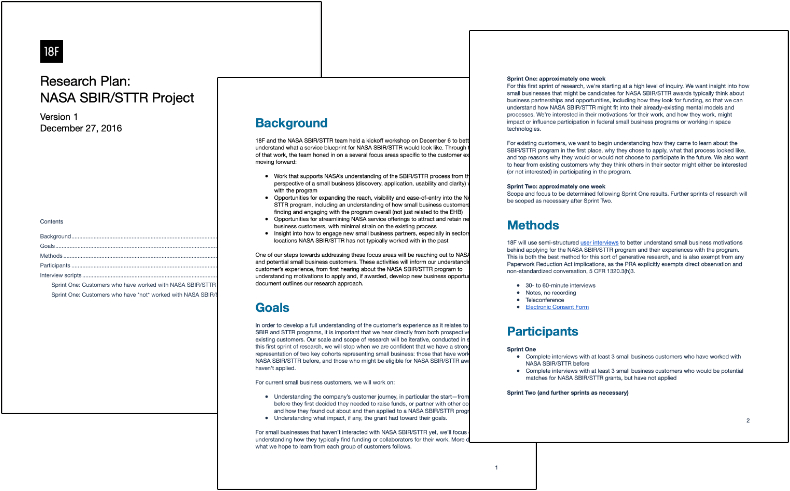Each year the US National Aeronautics and Space Administration (NASA) Small Business Innovation Research (SBIR) and Small Business Technology Transfer (STTR) programs fund small businesses to provide innovative solutions to NASA problems. The NASA SBIR/STTR team reached out to 18F to help them use design methods to streamline their funding application process in a user-centered way. I filled the roles of lead strategist and service designer.
What we did

We kicked off with an in-person workshop at NASA headquarters to set the vision for the project; begin to gather insights about the existing process, systems, and customers; better understand and identify weaknesses in existing customer touchpoints; and begin development of a SBIR Service Blueprint.
The workshop exercises culminated with the participants drafting an early version of a service blueprint of their application and awards process. My team was then able to use this first draft as a baseline, identifying areas that needed further definition and layering user journey information on top of it to identify key customer painpoints.

Next up: user research. We prepared a detailed research plan to guide our work, and reached out to NASA’s existing and potential small business customers. This informed our understanding of the customer’s experience, from first hearing about the NASA SBIR/STTR program to understanding motivations to apply and, if awarded, develop new business opportunities.
We started at a high level of inquiry to gain insight into how small businesses that might be candidates for NASA SBIR/STTR awards typically think about business partnerships and opportunities, including how they look for funding, so that we could understand how NASA SBIR/STTR might fit into their already-existing mental models and processes. That work then informed subsequent rounds of interviews, and eventually, an in-depth report that synthesized and summarized key insights.

With insights from user research in hand, my team created a revised service blueprint that layered a synthesized customer journey on top of the standard blueprint layout. This meant that the NASA team would have a visual roadmap to their application and awards process today (from customer touchpoints through to backend computer services and back again), plus a clear indicator showing where their customers are most happy and least happy with this process. They could then use information to prioritize process and system improvements, updating the service blueprint as they went as a living map.

Based on what we knew after our research and development of the service blueprint, we recommended an initial scope of process improvement work around applicant communication. The NASA team agreed, so we conducted a content audit of NASA SBIR/STTR communication properties, and did gap analysis of that current state versus customer needs identified in the service blueprint. We also went through several iterations of content design work that we usability tested with target audiences, including via 1:1 interviews, hallway tests, and a facilitated group activity at the NewSpace Conference. The goal? Ensuring that the NASA SBIR/STTR message was as clear as it could be.

Several years after the project, we were gratified and honored to hear that the NASA SBIR/STTR team still used the service blueprint we co-created. It still helps guide program improvements, which was our ultimate goal: provide a design process and artifact that could support innovation long after the 18F team was no longer in the picture.
Credit for this work goes to the 18F team (Jamie Albrecht and Chris Goranson, in addition to myself, plus Amber Reed who brought the visual communication design of the final service blueprint to the next level) and our colleagues at NASA SBIR/STTR.
